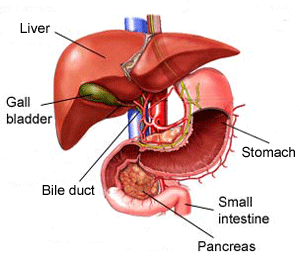Liver: Difference between revisions
Created page with "The liver is a vital organ in all vertebrates as well as some invertebrates (eg octopuses and other cephalopods). It is both the largest solid organ and the largest gland wi..." |
No edit summary |
||
| Line 1: | Line 1: | ||
The liver is a vital organ in all vertebrates as well as some invertebrates (eg octopuses and other cephalopods). It is both the largest solid organ and the largest gland within the human body, weighing ~1.8kg in men and 1.3kg in women<ref name="The British Liver Trust">http://www.britishlivertrust.org.uk/home/the-liver.aspx</ref>. | [[Image:Liver_diagram.gif|frame|right|Diagram showing the connection of the liver to the small intestine via the hepatic portal vein.]]The liver is a vital organ in all [[vertebrates]] as well as some [[invertebrates]] (eg octopuses and other cephalopods). It is both the largest solid organ and the largest gland within the human body, weighing ~1.8kg in men and 1.3kg in women<ref name="The British Liver Trust">http://www.britishlivertrust.org.uk/home/the-liver.aspx</ref>. It plays a vital role in [[Metabolism|metabolism]] and has a wide range of functions within the body, including [[Glycogen|glycogen]] storage, detoxification and [[bile|bile]] production. | ||
<div><div> | |||
This organ has remarkable regenerative abilities which allows surgeons to perform liver transplants where the donor is still alive. The liver is approximately halved during the surgery and within 4-8 weeks it should have grown back to it's normal size<ref>http://www.transplant.bc.ca/pre_livingliver.htm</ref>. This ability also means that, in transplantations where the donor is deceased, there is a possibility that it can be given to two patients rather than the one. | |||
<references /> | |||
<br> | |||
=== References === | |||
<references /> | |||
</div></div> | |||
Revision as of 14:41, 11 November 2011

The liver is a vital organ in all vertebrates as well as some invertebrates (eg octopuses and other cephalopods). It is both the largest solid organ and the largest gland within the human body, weighing ~1.8kg in men and 1.3kg in women[1]. It plays a vital role in metabolism and has a wide range of functions within the body, including glycogen storage, detoxification and bile production.
This organ has remarkable regenerative abilities which allows surgeons to perform liver transplants where the donor is still alive. The liver is approximately halved during the surgery and within 4-8 weeks it should have grown back to it's normal size[2]. This ability also means that, in transplantations where the donor is deceased, there is a possibility that it can be given to two patients rather than the one.